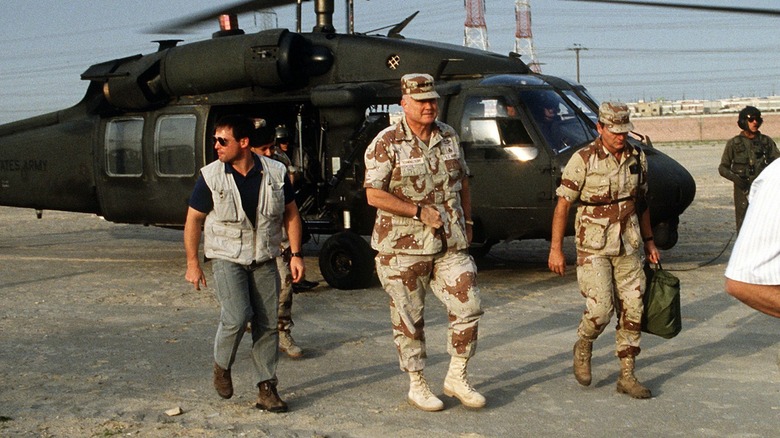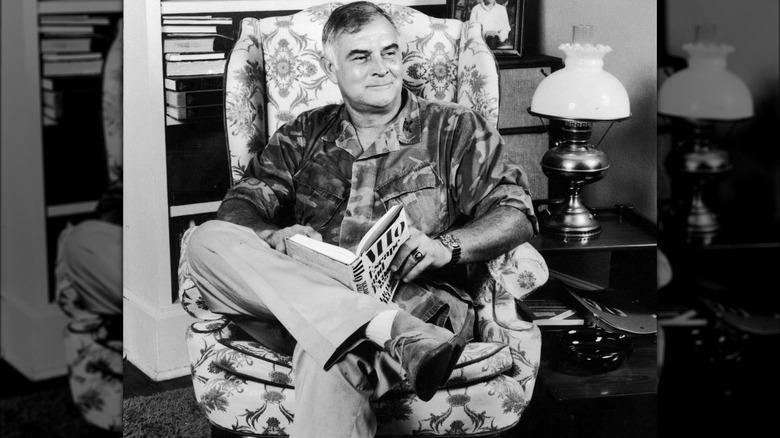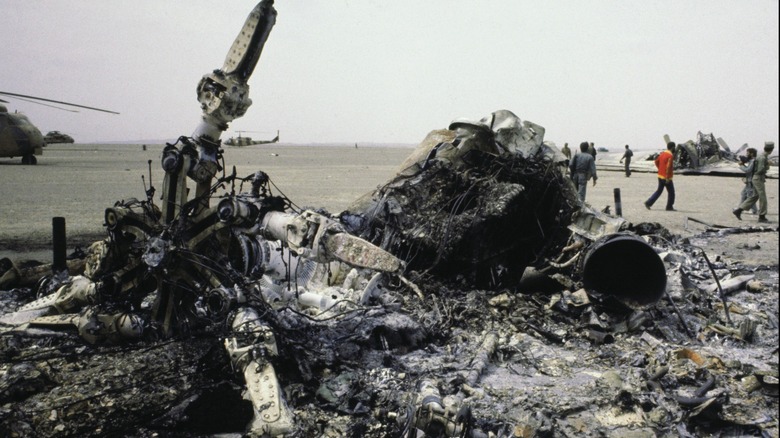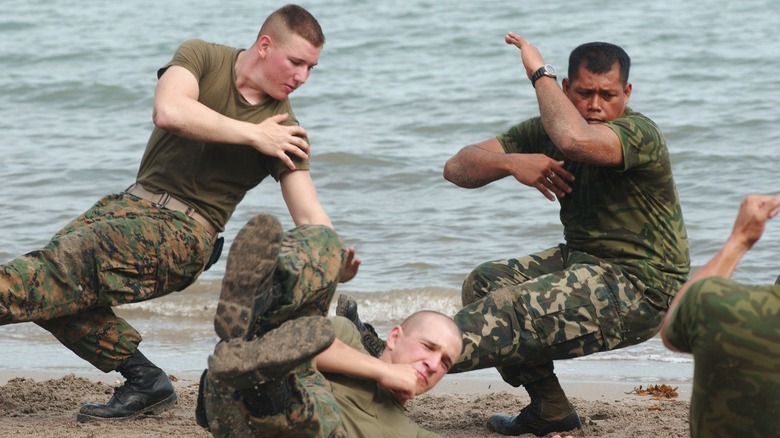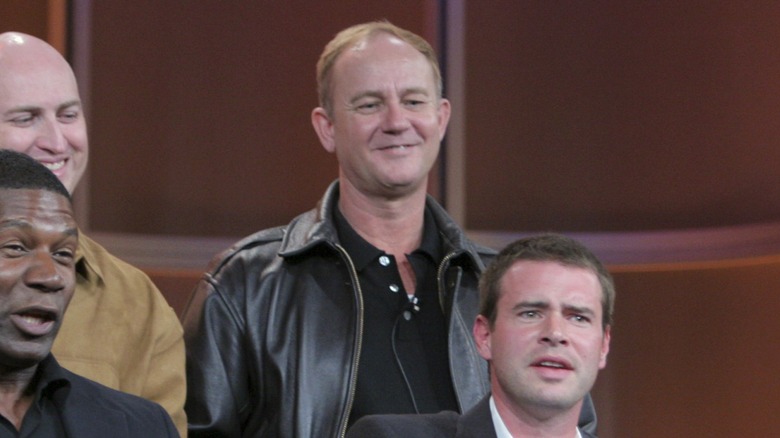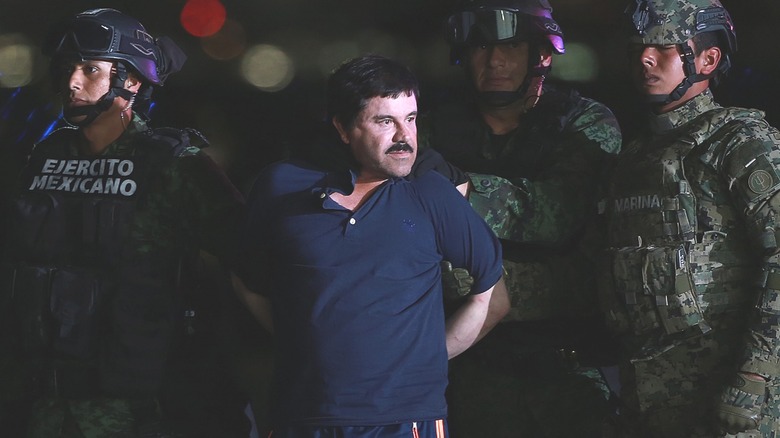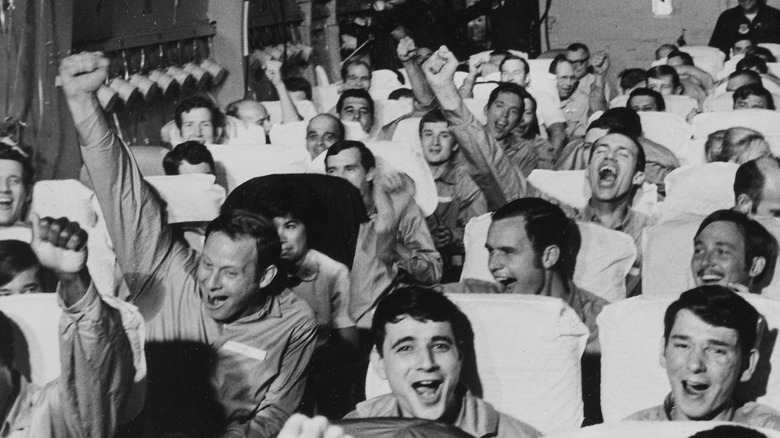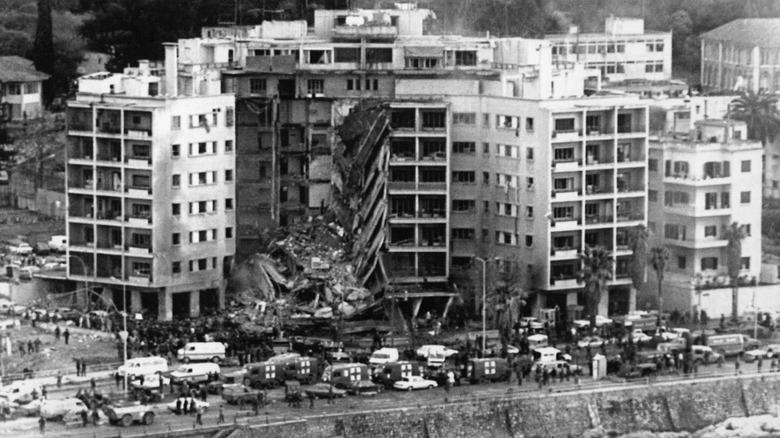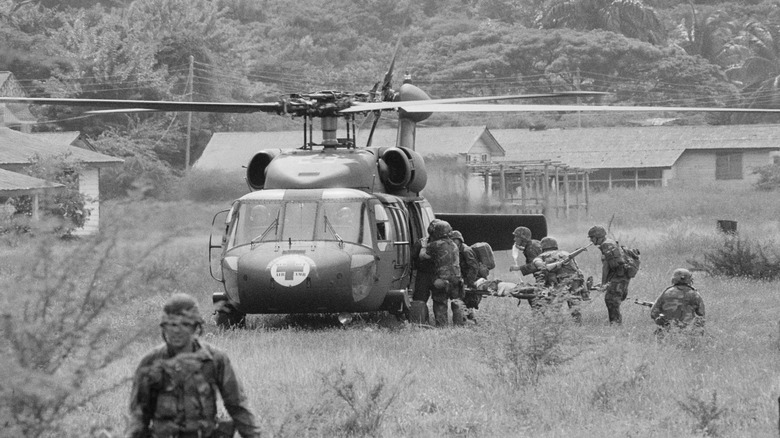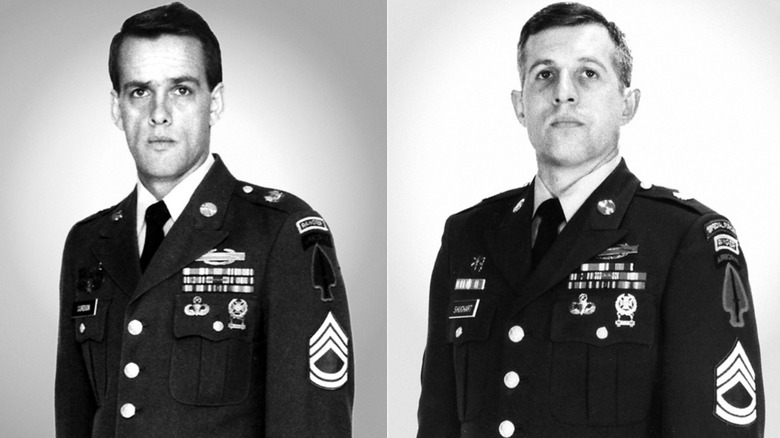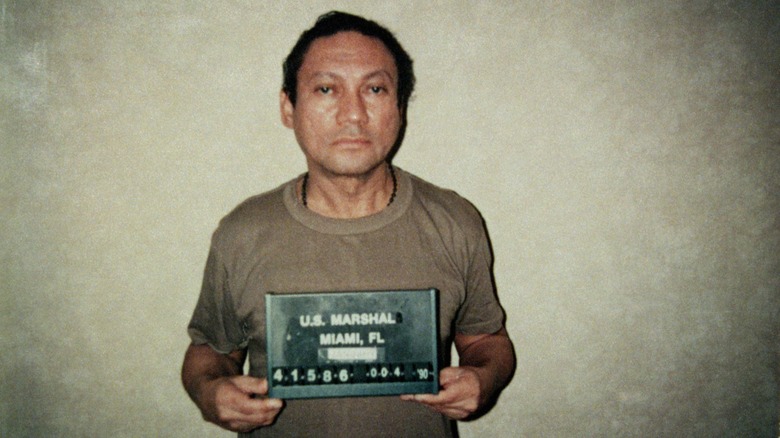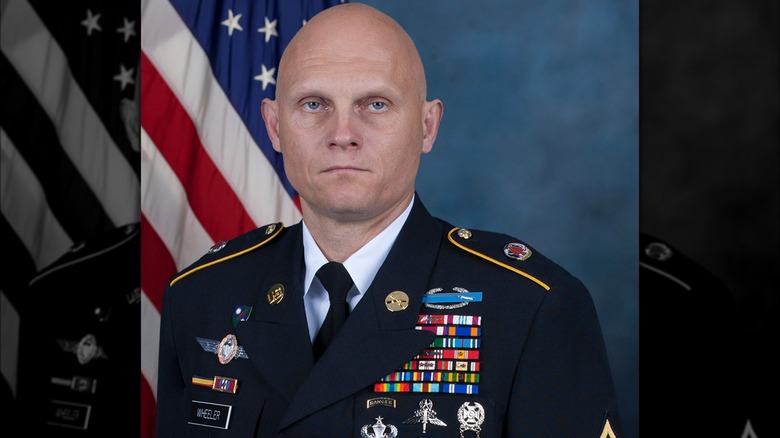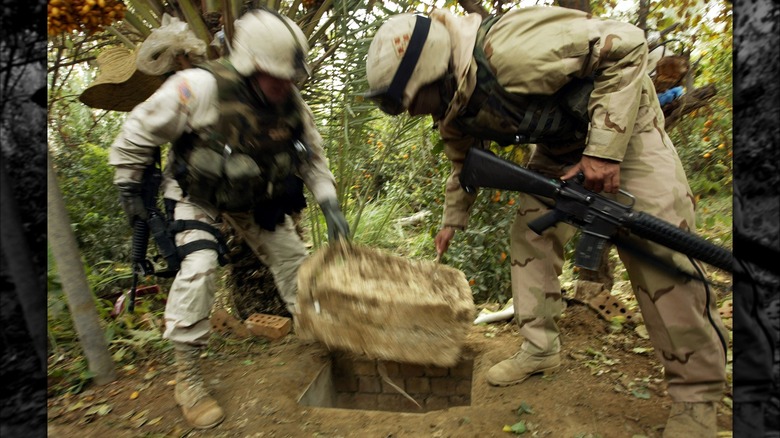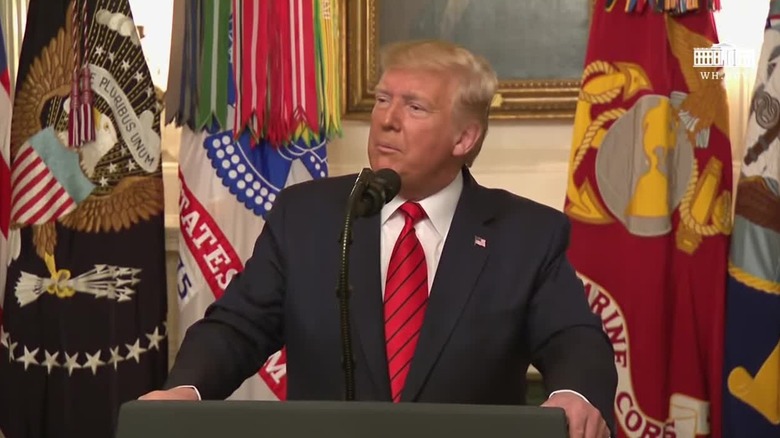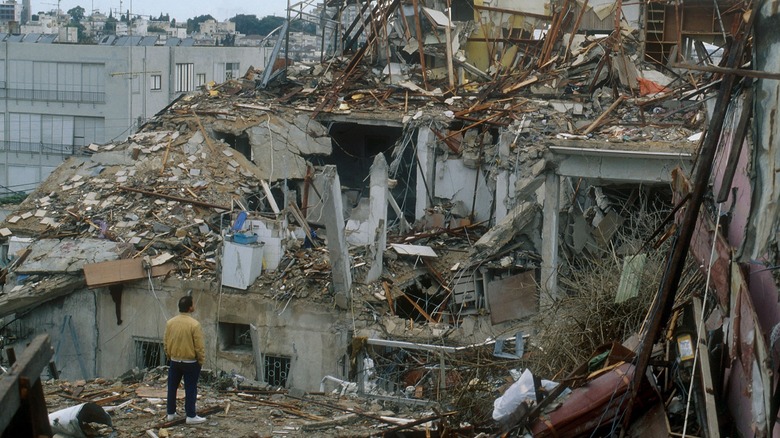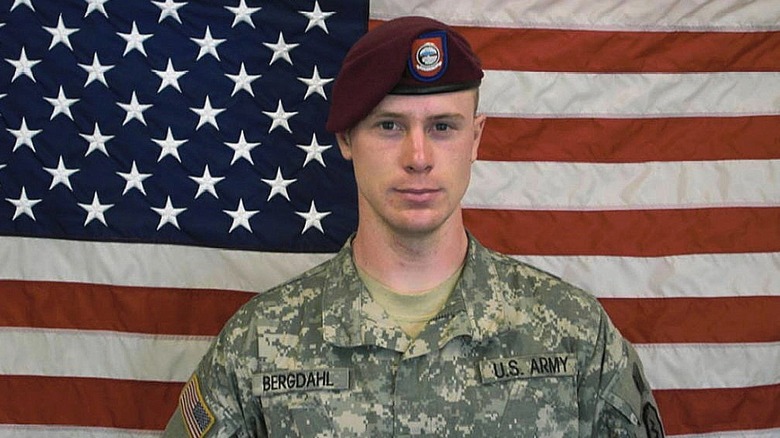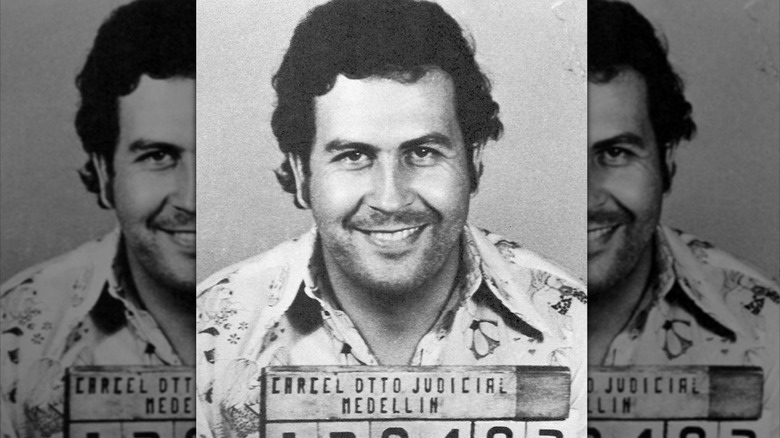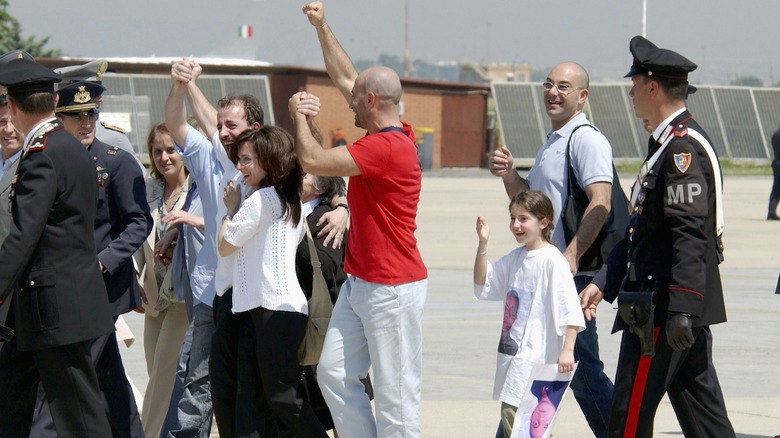The Untold Truth Of Delta Force
Considering they are one of the most secretive units in the U.S. military, it shouldn't come as a big surprise if you have never heard of Delta Force. Looking back, Delta Force first came to the public's attention back in 1983, when its creator, Col. Charles Beckwith, acknowledged their existence in a book. In their time, they have been involved in countless missions, though most of them are highly classified. Delta Force officially dates to 1977, making them relatively young by U.S. military standards, but along with SEAL Team Six, they are one of the most important counter-terrorist groups in the entire U.S. armed forces.
Delta Force is stationed at Fort Liberty in North Carolina along with the rest of the Joint Special Operations Command (JSOC), though the government doesn't actually officially acknowledge Delta's existence. Previously, they were internally codenamed as the 1st Special Forces Operational Detachment-Delta (1st SFOD-D) and then the Combat Applications Group (CAG). Now, they are officially called the Army Compartmented Elements (ACE), though they largely retain the informal Delta Force moniker among civilians. Delta combat personnel are known as "operators" rather than soldiers.
The training is rigorous and most of those who apply do not make the cut. Though they have largely stayed out of the limelight to preserve their secrecy, a little bit of information has trickled out over the years about them. This is the untold truth of Delta Force, one of the most mysterious units in military history.
A Vietnam veteran created Delta Force
There is perhaps no one more important to Delta Force history than the man who created it, Col. Charles Beckwith. A native of Georgia, Beckwith was a great athlete who nearly played for the NFL. However, he ended up joining the Army instead and subsequently served during both the Korean and Vietnam Wars. While in Vietnam, in the summer of 1965, Beckwith started participating in an operation known as Project DELTA, which was sort of a precursor to Delta Force (via Beckwith's autobiography "Delta Force: The Inside Story of America's Super-secret Counterterrorist Unit").
Project DELTA involved collaboration between the U.S. and Vietnamese Special Forces. Beckwith was in charge of DELTA, and he tried to model it on a previous Special Forces paper he had written. One of DELTA's earliest missions involved Beckwith's team helping rescue besieged Green Berets, and the mission was ultimately a success resulting in nearly 1,000 enemy soldiers killed.
After the war, Beckwith was assigned to study with the British Special Air Services (SAS), and he wrote a report about their use of Special Forces. In 1976, when the army started to consider building their own SAS-Special Forces-like unit, they looked to Beckwith and his report, and in January 1977, Beckwith formally pitched the idea of Delta Force to his commander as a counter-terrorism unit. It was a success, and on November 19, 1977, Delta Force was officially activated, with Beckwith as the head.
Their first operation was a disaster
Today, Delta Force is considered one of the most elite groups within the U.S. military, but that doesn't mean all of their missions have been successful. In fact, the very first operation they took part in, the attempted rescue of hostages from Iran on April 24, 1980, was a complete and utter disaster. The hostage crisis dated back to 1979, when Iranian militants stormed the U.S. embassy in Tehran and kidnapped dozens of Americans during the Iranian Revolution.
With negotiations to free them breaking down, U.S. President Jimmy Carter authorized the covert rescue mission, and the task, codenamed Operation Eagle Claw, fell to the practically brand new Delta Force. The initial plan was to fly 118 men into Iran near Tehran, where they would storm the embassy and rescue the hostages. Unfortunately, things were doomed from the beginning, when multiple helicopters experienced severe problems. This caused the mission to be aborted after it had already started, and in the process there was a nasty collision between a C-130 aircraft and a helicopter, killing eight American troops.
The troops quickly got out of the area, but in their haste left behind both the bodies of their fallen comrades as well as several helicopters (they had planned on blowing them up, but did not). The hostages remained imprisoned for almost a year more. Their inaugural mission was a disaster, but thankfully first impressions would not prove lasting with Delta Force.
The House of Horrors training complex
It's no secret that only the best and most excellent of candidates make it into the highly exclusive Delta Force. Much of this has to do with the intense training requirements expected of Delta Force operators, and around 90% of those who try to join will wash out before they make it. While much of their training regime is kept secret, in his book "Delta Force," the group's creator Col. Charles Beckwith described some of the early tests that new recruits had to undergo if they wanted a shot at joining.
Among these tests was the "House of Horrors" building. The House of Horrors was a $90,000 complex built to train operators in all sorts of counter-terrorist and hostage rescue tactics. It consisted of four rooms that could be mocked up to resemble various scenarios, from night assaults to potential aircraft hijackings. It separated the imposters from the real recruits, and was a gauntlet to run.
Apparently, Delta Force took its inspiration for the House of Horrors from the British Special Air Services (SAS) similar version of the complex, which the SAS calls the Killing House. The House of Horrors was/is an extremely rigorous and demanding course, but one that definitely ensures all Delta Force operators are ready for a myriad of different tasks.
Training can involve the FBI
In 1979, when the State Department was trying to beef up security at several of their foreign embassies, they looked to Col. Charlie Beckwith and his newly established Delta Force for troops. According to one of the recruits Eric L. Haney (pictured) in his autobiography "Inside Delta Force: The Story of America's Elite Counterterrorist Unit," selected operators immediately began training to defend U.S. ambassadors from potential threats or unexpected occurrences. These could include a range of things, like getting a flat tire or going to a dinner party that suddenly becomes the target of enemy rocket fire.
In order to prove that they had absorbed their training, Haney and his comrades were put through a very unique test. They were given a mysterious envelope with instructions that guided them all over to meet a series of undercover contacts and/or retrieve more hidden instructions. In addition to having to navigate a city using hidden clues, to make things extra tough, their commander told the FBI to be on the lookout for them and begin a manhunt.
In the end, Haney and his teammates were able to complete their test, which involved stealing sensitive information from the Naval Observatory, National Guard Armory, and Andrews Air Force Base. They proved no match for the FBI, who didn't manage to snag a single one of them, and showed why Delta operators are Delta operators.
They may have helped capture El Chapo
Since the 1980s, Joaquin "El Chapo" Guzman-Loera has been the scourge of international drug enforcement agencies. As the head of the drug trafficking of the Sinaloa Cartel, El Chapo helped smuggle untold amounts of drugs through pipelines leading from Central America to around the world. He has spent much of his life on the run from law enforcement, but it seems like he couldn't quite escape the tentacles of Delta Force.
El Chapo first served prison time in Mexico from 1993–2001, but escaped and was free until 2014 when he was rearrested. He then escaped again in 2015 while still awaiting trial, but Mexican authorities finally recaptured him in early 2016. According to an article on SOFREP (warning: graphic images), Mexican Marines captured El Chapo in 2016 with the help of Delta Force operators. The Delta operators allegedly did not participate in the raid themselves and only provided tactical assistance, which would have still been a pretty significant help.
However, a report from The Washington Post cast doubt on whether or not Delta operators were involved in the capture, and the Mexican government officially denied any involvement. Yet, considering the U.S. doesn't even officially acknowledge their existence, it wouldn't be too surprising if Mexican authorities omitted Delta's name on purpose. We'll never know for certain, but El Chapo is now serving life with little chance to escape again, potentially thanks to Delta.
They may have almost rescued POWs in Vietnam
Of all the outstanding issues leftover from the ill-fated Vietnam War, the controversy of American soldiers who were Prisoners of War (POW) is one of the thorniest. Officially, the United States and Vietnamese governments hold that following the end of the war and Operation Homecoming, which repatriated 591 American POWs home, no other POWs remained in Vietnamese custody. Yet, for decades unofficial rumors have circulated that there were indeed still POWs who were left behind after the war ended, and apparently, there were more than a few rescue missions that nearly took place.
At least two of the alleged missions involved Delta Force and almost happened in 1981 and 1982, nearly a decade after the end of the war. As former Delta Force operator Eric L. Haney details in his book "Inside Delta Force," elements of the U.S. government were under the impression that around 125 POWs were being held in neighboring Laos. Delta was called on to initiate the rescue operation, and soon they were having dress rehearsals that involved Air Force pilots.
At the last minute, the higher-ups ended up scuttling the mission after fearing the rescue had drawn too much attention. They tried again a year later, but once again the mission was aborted before it could begin. Hopefully, the intelligence was bad and there were no POWs, but it's an eye-opening revelation about the extensive prerogative of Delta Force.
One member was a victim in the 1983 Beirut embassy bombing
The 1983 Beirut embassy bombing was one of the most tragic incidents in American military history. The bombing took place during the Lebanese Civil War, and it was one of the most visible signs of the United States' short-lived involvement. At the time of the bombings, the U.S. had troops stationed in the country as part of a peacekeeping force. The first U.S. forces had arrived in the country a year earlier as part of a larger international peacekeeping force, and though it was not officially talked about, that included a few Delta Force operators, too.
The suicide bombing occurred on April 18, 1983, and at least two Delta Force operators were at the embassy when it happened. One of them, SFC Terry Gilden, was standing outside of the embassy and was killed in the blast. The other, Rick Downing, was hurled through a doorway of his office upstairs in the building from the explosion but thankfully managed to survive after being briefly knocked out. After coming to, he organized and assisted in evacuating the American ambassador to safety, before helping to do the same with the remaining wounded and injured.
There were 63 victims in the attack, including Gilden, the lone Delta operator known to have died. Gilden was later awarded the Legion of Merit by the Army, and was a six-year veteran at the time of his death.
Delta Force participated in the invasion of Grenada
Depending on who you ask, the United States invasion of Grenada was either a rousing success or an inappropriate and vulgar display of power against a sovereign nation. The mission, officially known as Operation Urgent Fury, took place on October 19, 1983, following a far left-wing coup in Grenada by the Military Revolutionary Council (MRC). Immediately after the coup, the U.S. invaded, ostensibly to protect U.S. citizens who were students in the country, but in reality to unseat the new radical government.
One of the units that participated in Urgent Fury was Delta Force, which had two squadrons assigned, A and B-Squadron. B-Squadron was mainly tasked with liberating a prison, while A-Squadron was supposed to attack an installation after their teammates had completed their mission. Unfortunately, things were off the rails from the beginning. As soon as B-Squadron approached their target their helicopters came under intense enemy fire, resulting in several wounded men and causing them to retreat and offload the wounded on a Navy destroyer. Subsequently, when A-Squadron tried to land they also ran into heavy arms fire, leaving them to turn around, too.
One of the team's helicopters was hit with so much gunfire that it crash-landed, resulting in several operators' deaths and more injuries. While the larger Operation Urgent Fury was tactically a success, overall, it was a disastrous outing for Delta Force. They would recover to fight again, but it was an operation most would probably rather forget.
Two members earned the Medal of Honor during Black Hawk Down
Forever immortalized in the Ridley Scott film "Black Hawk Down," the 1993 Battle of Mogadishu is one of Delta Force's most publicized missions in history. The battle took place between October 3-4, 1993, when U.S. forces entered Somalia in an attempt to oust a local warlord in control of part of the country. Officially known as Operation Gothic Serpent, Delta Force made up a large contingent of the troops participating.
The mission sadly ended up being a failure and tragedy, resulting in more than 100 U.S. casualties, 13 UN casualties, and as many as 1,500 Somali deaths. Among the KIA were Delta operators SFC Randall David Shugart (above right) and M/Sgt. Gary Ivan Gordon (above left), who were also awarded the Medal of Honor for their heroics during the battle. During the fighting, both Gordon and Shugart volunteered to help secure the site of a U.S. helicopter crash that was in danger of being overrun by militants. Despite knowing that the mission was extremely dangerous and would likely lead to their deaths, the men still volunteered to rescue the fallen pilots.
They arrived at the crash site with no reinforcement but still managed to hold off the militants for several minutes. Eventually, they ran out of ammunition and succumbed to the attackers, but their stand saved the crashed pilot's life. It was a daring display of heroism and bravery, and was undoubtedly worthy of the Medal of Honor they earned.
They rescued a hostage during the invasion of Panama
In addition to having an exceedingly cool name, Operation Acid Gambit was one of Delta Force's best missions, even if it is not very widely known. The mission took place on December 20, 1989, during Operation Just Cause, or the ousting of Panamanian dictator Manuel Noriega (pictured) from power. Noriega had been in charge of Panama since 1983 as the head of the military, and he was actually a former CIA informant.
However, by the late 1980s, he had run afoul of the U.S. government over his illicit drug trafficking and suspected role in the murder of political opponent Hugo Spadafore. He was indicted on drug charges in U.S. court in 1988, and in early 1989 he had Kurt Muse, an American undercover CIA agent living in Panama, arrested and sent to the infamous La Modelo prison. Nine months later, the U.S. sent in a force 24,000 strong to take Noriega out of power, including Delta Force on Operation Acid Gambit to rescue Muse.
Under threat of Muse's execution, Delta operators landed on top of La Model and fought their way through to his cell under heavy fire, rescuing him and making their way out suffering three casualties and no fatalities. The entire operation was brutally efficient, and it took Delta operators only six minutes from start to finish to complete the job. Delta saved Muse's life with the rescue, but then it was just another day at the office.
Members have to hide their affiliation
For most people, filling out and compiling a resume is pretty straightforward. You list out your basic skills, education, and job experience, usually including your official role and the name of your company and superior. Except, what are you supposed to do when your official title and the name of your company are classified and the identity of your superior doesn't legally exist? Well, as members of Delta Force can attest, you have to get a little creative.
Due to the highly secretive and officially classified existence of Delta Force within the military, members can't exactly divulge their official titles and jobs when they fill out resumes or update their LinkedIn pages. That results in operators giving themselves unique titles that hide their official affiliation, while still giving a nod to their duties and responsibilities. As The Washington Post explains, this leads to some men putting their military detachments as things like "Special Mission Unit" to obfuscate their real name.
Even once they get into their interviews, there are strict limits on what they can even talk about in relation to their Delta history because so much of it needs to stay secret. And after all, most interviewers won't just believe you if you say your work history is highly classified. It's an interesting tightrope current and former Delta members have to walk and one that most people probably don't even think about.
The first U.S. casualty against ISIL was a Delta Force operator
Since the early 1990s, Delta Force operators have been fighting in combat in Iraq against deadly forces. They fought in the Persian Gulf War in 1991 and then the invasion of Iraq in 2003, staying for nearly a decade in the latter until leaving in 2011. However, they returned once more in 2014 to respond to the new threat from the Islamic State of Iraq and the Levant (ISIL), which started the fighting all over again.
On October 22, 2015, Delta Force operators participated in a prisoner rescue operation in Hawija, which resulted in 70 prisoners being saved from ISIL militants. However, during the rescue a Delta operator, M/Sgt. Joshua Wheeler was killed. Originally, the raid was only supposed to be undertaken by Kurdish fighters and the Delta operators were just going to observe. Yet, when things started to go south, Wheeler and the other Delta operators jumped in to lend a hand. They soon took charge of the assault into the prison, which led to Wheeler's death.
Wheeler was the first U.S. soldier killed in the year since American forces began fighting again in Iraq. No American had died there since 2011, when the military had previously pulled out, making Wheeler's death even more tragic. Wheeler was awarded the Silver Star posthumously for his actions.
Delta operators helped capture Saddam Hussein
The beginning of the end started for Saddam Hussein when U.S. forces invaded Iraq on March 20, 2003, but it was Delta Force operators who delivered the final blow nine months later in December. Following accusations of harboring weapons of mass destruction and illegally selling oil while under United Nations sanctions, the U.S. stormed Iraq in early 2003 with the explicit intention of removing Hussein from power forever.
Unfortunately, even though they were successful at ousting him from office and ending his murderous dictatorship, U.S. forces were unable to immediately capture the man himself. In July, they killed two of his sons Uday and Qusay, but their father Saddam still eluded his captors. That was until December, when members of the secretive Task For 121 found him near Tikrit. Task Force 121 was made up of several Special Forces units, including Delta Force. Known as Operation Red Dawn, Task Force 121 raided a farm just south of Tikrit acting upon intelligence from a captured Hussein confidant.
Members of Task Force 121 found Hussein hiding in a hole on the farm looking disheveled and bedraggled. They immediately took him into custody after he had been on the run for nine months, and almost exactly three years later he was executed. That wouldn't be the last time Delta Force operated within Iraq, but was definitely one of the most important, if largely unknown, moments.
They took out the head of ISIL in 2019
For many years, Abu Bakr al-Baghdadi was one of the most feared and infamous men in the entire world. As the head of the Islamic State of Iraq and the Levant (ISIL), al-Baghdadi was one of the biggest enemies on the American intelligence radar and a constant target for capture. Amazingly, when the U.S. finally caught up to him in 2019 after years of failed attempts, it was none other than Delta Force who arrived on his doorstep.
Initially, al-Baghdadi came to American attention during the 2003 invasion of Iraq, when he was briefly detained over his ties to his militant brother-in-law. However, he was inexplicably released in 2004, and by 2010 he had declared himself the head of the new terrorist group ISIL's caliphate in Iraq. The Obama administration tried and failed to capture al-Baghdadi, and it was not until 2019 that the CIA was able to assist in locating him, partly through interrogating one of his wives.
Delta Force commanders, along with at least one military dog, assaulted the compound that al-Baghdadi was hiding out in on October 27, 2019. According to then-President Donald Trump, the operators tracked him down to an underground tunnel, and he blew himself and some of his children up with a suicide vest to prevent himself from being captured. Initial reports immediately identified Delta Force as involved, but military officials stayed hushed on their participation, never officially acknowledging their role, which isn't exactly surprising.
They saved Israel from an attack
Of all of Delta Force's countless missions, one of their most important took place during the Persian Gulf War of 1991, when U.S. forces invaded Iraq to stop their occupation of neighboring Kuwait. While the Gulf War is a pretty well-studied event, most people don't realize that Delta Force played an important role in stopping the war from expanding.
Beginning just days after the U.S. began their invasion, the leader of Iraq Saddam Hussein authorized the launching of SCUD ballistic missiles into Israel and Saudi Arabia. This resulted in the death of at least 13 Israelis and injuries to 77 Saudis, and almost brought Israel into the war to take on Hussein. Hussein likely theorized that bringing the Israelis into the conflict would have likely fractured the international coalition which also consisted of some Arab states, allowing himself an easier time surviving. At first, the U.S. was unable to knock out the SCUDs, and Hussein kept firing them into Israel. This threatened to drastically change the war, but President George Bush diplomatically kept persuading Israel to stay out. Finally, on February 27, 1991, Hussein planned one final barrage of 26 SCUDs to finally tip Israel's hand.
Luckily, however, Delta operators located all of the 26 SCUDs and neutralized them before they could be activated. Like most of their accomplishments, the public never knew or realized their massive contribution, but without Delta, the Middle East might be drastically different today.
Delta Force took part in the controversial Bowe Bergdahl exchange
The Sgt. Bowe Bergdahl exchange was one of the most controversial and contentious prisoner swaps in history, and would you believe that Delta Force was right in the thick of it? Bergdahl, a former sergeant in the Army, is infamous for his 2009 capture by Taliban militants while he was stationed in Iraq. It occurred after he had voluntarily and illegally vacated his post on the front lines, and he wound up being imprisoned by the Taliban for almost five years. During his time in captivity, Bergdahl was tortured at the hands of his captors.
Bergdahl was swapped in 2014 while the U.S. released Taliban members who were in the military prison at Guantanamo Bay. Due to the high-profile and extremely dangerous nature of the swap, the army tapped Delta Force to take part in the exchange. Thankfully, everything went off without a hitch, and Bergdahl was quickly flown out of the area by Delta operators who brought him back to a U.S. base for the first time in years.
Had things gone south, few units would have been better to take on the Taliban fighters than Delta Force. As for Bergdahl, he was dishonorably discharged from the army in 2017, though his court-martial was later overturned in 2023.
A Delta Force operator may have killed Pablo Escobar
By late 1992, the manhunt for notorious drug trafficking kingpin Pablo Escobar was operating at full steam. Escobar was infamous as the head of the Medellin cartel, one of the biggest drug trafficking cartels in the world. Escobar himself had become an extremely rich man on the back of the profits, but he was also wanted by law enforcement everywhere. He surrendered to Colombian authorities in June 1991, but he easily escaped their custody just a year later.
On the run again, the Colombian government enlisted the help of the U.S. to track down Escobar and bring him to justice. They wanted Delta to do the tracking, and President George Bush authorized them to get involved, leading to an eight-man force being deployed to Colombia. They called the mission Operation Heavy Shadow, and it ended with a bullet to Escobar's brain courtesy of an American sniper. In his 2001 book "Killing Pablo: The Hunt for the World's Greatest Outlaw," author Mark Bowden theorized that it may have even been a Delta operator who fired the fatal shot due to its precision and their known involvement.
However, the Delta commander that day, Col. Jerry Boykin, has officially denied that it was a Delta operator, so it's impossible to say for sure. Either way, Delta played a huge role in Escobar's ouster, even if they didn't necessarily pull the final trigger.
They helped rescue Italian and Polish hostages from Iraq
Seventeen seconds. That's how long it took for Delta Force operators to storm through an Iraqi militant complex and rescue four imprisoned hostages. The raid took place on June 8, 2004, while the U.S. was at the height of the invasion of Iraq. The hostages, a mix of Italian and Polish contractors, had been kidnapped from Baghdad months earlier, and another one of them, an Italian, had been murdered by the militants in a grisly execution caught on videotape in April.
After an agonizingly long search, Special Forces intelligence led Delta operators to a complex where it was believed the hostages were being kept. With little time to spare, the Delta operators boarded helicopters and were on their way to the compound to break them out. In less time than it took to read this article, the operators had completely conquered the entire building and had all four of the surviving hostages in tow.
Incredibly, Delta pulled off the entire operation in broad daylight, which only adds to their immense legend. Few teams could have pulled off the rescue with the precision and skill of Delta, but that's what makes them truly elite.
